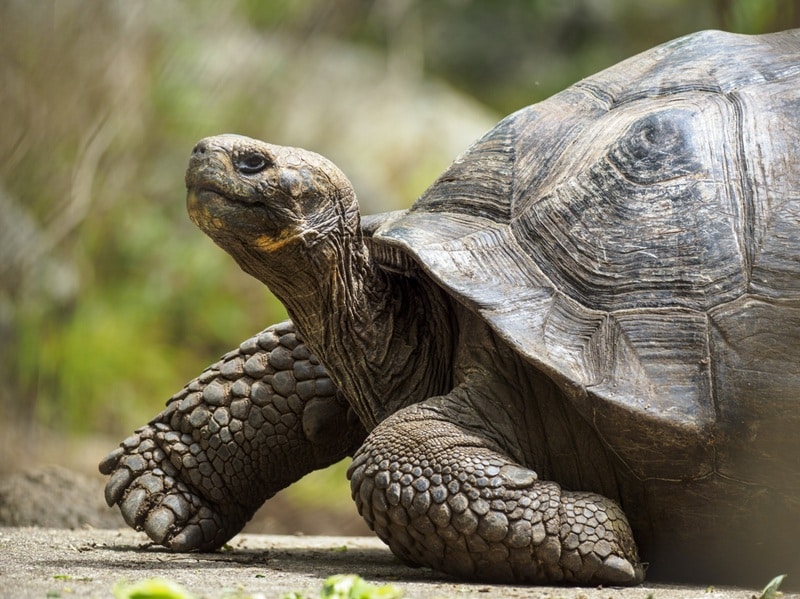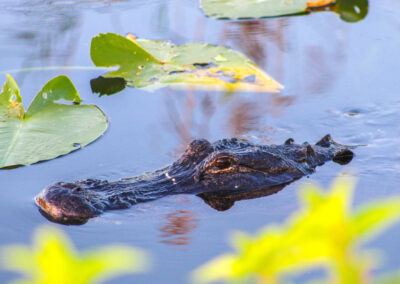Tortoises and turtles are both members of the reptile order Testudines, but they’ve evolved in dramatically different ways to suit life on land and in water. While their hard shells and slow-moving reputations might make them seem similar, everything from their feet to their diets to their lifespans reveals distinct differences.
In this article, we’ll break down the key differences between tortoises and turtles—starting with an at-a-glance comparison and then diving deeper into each reptile’s classification, anatomy, habitat, diet, and more.
The Most Important Differences Between Tortoises and Turtles
The most important difference between tortoises and turtles comes down to habitat: tortoises are strictly land-dwellers, while turtles are adapted to life in the water or at least spend significant time in it. This core difference has shaped their evolution in distinct ways—impacting not just their shell shape, limb structure, diet, and movement, but also their size range, coloration patterns, and even how they communicate.
Here’s a quick overview of how tortoises and turtles compare across these key traits:
Tortoise vs. Turtle Comparison Table
| Feature | Tortoise | Turtle |
| Habitat | Land only | Aquatic or semi-aquatic |
| Shell Shape | High-domed and heavy | Flat and streamlined |
| Limbs | Column-like legs with claws | Webbed feet or flippers |
| Diet | Primarily herbivorous | Omnivorous or carnivorous |
| Lifespan | Often over 100 years | 20–80 years depending on species |
| Movement | Slow walker | Strong swimmer |
| Reproduction | Land nesting | Nests on beaches or near water |
| Pet Suitability | Common and low-maintenance | Less common and more complex care |
| Size | 4 in to 5 ft; up to 550+ lbs | 3 in to 8 ft; up to 2,000+ lbs |
| Coloration | Earth tones: brown, gray, olive, black | Varies widely: green, yellow, red, patterned |
| Sound | Grunts, hissing, rasping during mating/stress | Low-frequency chirps, clicks, groans, bellows |
Tortoise Facts and Information Overview
Tortoises are slow-moving, land-dwelling reptiles known for their dome-shaped shells, thick legs, and impressive longevity. Belonging to the order Testudines, tortoises have evolved to thrive in dry, terrestrial environments, where their sturdy build and protective shells help them survive predators, extreme heat, and scarce water resources. Unlike their aquatic turtle relatives, tortoises are strictly terrestrial and have specialized adaptations that reflect their land-based lifestyle.
Species & Classification
Tortoises belong to the family Testudinidae, a specialized group of land reptiles within the reptilian order Testudines. There are currently over 45 recognized tortoise species spanning diverse ecosystems across North and South America, Africa, Asia, and Europe. Unlike turtles, tortoises have evolved exclusively for life on land.
Some of the most well-known tortoise species include:
| Species Name | Common Name | Region | Average Size |
| Chelonoidis nigra | Galápagos Tortoise | Galápagos Islands | 4–5 ft, up to 550 lbs |
| Aldabrachelys gigantea | Aldabra Giant Tortoise | Aldabra Atoll, Seychelles | 3.5 ft, up to 500 lbs |
| Testudo horsfieldii | Russian Tortoise | Central Asia | 6–10 in, 2–4 lbs |
| Gopherus agassizii | Desert Tortoise | Southwestern United States | 10–15 in, 8–15 lbs |
These species vary widely in size and habitat preference, but all are characterized by their domed shells and columnar limbs
Size
Tortoises vary widely in size. At the small end of the spectrum is the Speckled Padloper Tortoise, which reaches only 4 to 5 inches in length and weighs under 1 pound. On the other end are giant tortoises like those from the Galápagos and Aldabra Atoll, which can exceed 4 feet in length and weigh over 500 pounds.
| Species | Avg. Shell Length | Avg. Weight |
| Speckled Padloper | 4–5 in (10–13 cm) | <1 lb |
| Russian Tortoise | 6–10 in (15–25 cm) | 2–4 lbs |
| Sulcata Tortoise | 18–30 in (45–76 cm) | 70–100 lbs |
| Galápagos Tortoise | 4–5 ft (120–150 cm) | 400–550 lbs |
Larger species tend to have longer lifespans and slower growth rates.
Shell Shape & Structure
A tortoise’s shell is one of its most defining features. Unlike turtles, which need streamlined bodies for swimming, tortoises have high-domed, rugged, and heavy shells designed purely for land-based protection. Their shells are made up of two main parts: the carapace (top) and plastron (bottom), both formed from bone and covered in scutes (keratin plates).
The shell is fused directly to the spine and ribcage, making it an integral part of the tortoise’s skeletal structure. Its domed shape deters predators from biting or flipping them over and provides insulation from the sun’s heat. Unlike aquatic turtles, tortoises cannot retract fully into their shells in some cases due to their bulky limb structure—but their shells serve as a durable barrier against physical threats.
Coloration
Tortoises are generally colored in shades of brown, gray, olive, or black. These earthy tones help them blend into their environment, especially in dry, dusty habitats. The shell scutes may display patterns or concentric growth rings, which sometimes give clues to a tortoise’s age.
Some notable examples include:
- Indian Star Tortoise – displays yellow starburst patterns on a dark brown shell.
- Leopard Tortoise – shows black spots on a yellowish or tan background.
Coloration plays a role in camouflage, temperature regulation, and in some cases, species recognition.
Limbs & Movement
Tortoises are built for endurance and strength rather than speed. Their legs are thick, stumpy, and positioned directly beneath the body, allowing them to carry their heavy shells over long distances. These column-like limbs, similar to those of elephants, are designed for walking over rough and uneven terrain.
Each foot is equipped with sturdy, clawed toes that allow them to dig burrows for shelter or moisture retention in arid environments. Tortoises are not capable swimmers—they can actually drown in deep or fast-moving water due to their dense bodies and lack of buoyant features.
Despite their slow gait (averaging 0.2 to 0.5 mph), tortoises are surprisingly agile climbers and can travel significant distances when searching for food or mates.
Habitat & Environment
Tortoises inhabit a wide range of dry, terrestrial habitats, including deserts, grasslands, savannas, and scrublands. Their highest concentrations are found in Africa, Central Asia, the Middle East, and parts of North and South America, although isolated populations exist elsewhere.
They are particularly adapted to arid and semi-arid environments where water is scarce. Tortoises use their burrowing skills to create underground shelters called dens or burrows, which can span up to 30 feet long and 10 feet deep in species like the desert tortoise. These burrows help regulate body temperature and humidity, protecting them from extreme heat and predators.
Tortoises are ectothermic (cold-blooded), relying on external temperatures to regulate their body heat. In hot climates, they may be active only in the morning or evening to avoid overheating.
Diet & Feeding Habits
Tortoises are primarily herbivores, consuming a diet rich in high-fiber, low-protein vegetation. Common dietary staples include:
- Grasses and hay
- Leafy greens (e.g., dandelion, collard greens)
- Succulents and cacti
- Fruits (sparingly, due to sugar content)
- Wildflowers and weeds
Their beaks are strong and serrated, ideal for cutting and chewing fibrous plants. Unlike turtles, tortoises do not chew with teeth—they have hard ridges in the jaw that grind down vegetation. Their digestive systems are slow, and they rely heavily on gut bacteria to break down cellulose from plant matter.
Because they evolved in water-scarce environments, tortoises have efficient water retention and can go for weeks or even months without drinking, deriving moisture from plants and dew.
Sounds & Communication
While generally quiet, tortoises can produce audible sounds, particularly during mating season or when stressed. Common tortoise vocalizations include:
- Grunts or rasping hisses during mating behavior.
- A hissing sound caused by forced air expulsion when retracting into their shell.
- Occasional whining or groaning in large species like the Galápagos tortoise.
Tortoise sounds are low-frequency and not used for long-distance communication but are important during
⏳ Lifespan & Reproduction
Tortoises are among the longest-living animals on Earth. Many species commonly live over 80 years, and some, such as the Galápagos tortoise and Aldabra giant tortoise, are documented to live over 150 years. The oldest recorded tortoise was Adwaita, an Aldabra tortoise who reportedly lived to be over 250 years old.
Tortoises are oviparous, meaning they reproduce by laying eggs. During mating season, females dig shallow nests and lay clutches of 2 to 20 eggs, depending on the species. After covering the eggs with soil, the female leaves, and the hatchlings are left to survive on their own—there is no parental care in tortoise species.
Incubation can take 90 to 120 days, and the sex of the offspring is temperature-dependent—higher incubation temperatures often produce females, while cooler conditions yield males.
Turtle Facts and Information Overview
Turtles are highly adaptable reptiles known for their aquatic lifestyles, streamlined shells, and webbed or flippered limbs. Unlike tortoises, which remain land-bound, turtles have evolved to thrive in water—be it ponds, rivers, or oceans. Their body structures, diets, and behaviors reflect this aquatic adaptation. With over 300 species worldwide, turtles are incredibly diverse, ranging from small freshwater varieties to massive sea turtles that navigate entire ocean basins.
Species & Classification
Turtles fall under the order Testudines, but unlike tortoises, they are distributed across multiple families, including Cheloniidae (sea turtles), Emydidae (pond and box turtles), Trionychidae (softshell turtles), and Kinosternidae (mud and musk turtles). There are over 350 known turtle species, found on every continent except Antarctica.
Some of the most notable turtle species include:
| Species Name | Common Name | Habitat Type | Avg. Size |
| Dermochelys coriacea | Leatherback Sea Turtle | Oceanic (Marine) | 6–8 ft, up to 2,000 lbs |
| Trachemys scripta elegans | Red-Eared Slider | Freshwater (Ponds) | 6–12 in, 3–6 lbs |
| Chelonia mydas | Green Sea Turtle | Oceanic (Marine) | 3–4 ft, 300–500 lbs |
| Apalone spinifera | Spiny Softshell Turtle | Rivers and lakes | 5–20 in, 5–25 lbs |
Each species has adapted uniquely to its environment, with marine turtles being fully aquatic and others capable of limited land movement.
Size
Turtles have an impressive size range. The Bog Turtle, one of the smallest, measures just 3 to 5 inches and weighs under 1 pound. On the other end, the Leatherback Sea Turtle can grow over 6 feet long and weigh more than 2,000 pounds.
| Species | Avg. Shell Length | Avg. Weight |
| Bog Turtle | 3–5 in (7.5–13 cm) | <1 lb |
| Painted Turtle | 5–10 in (13–25 cm) | 1–2 lbs |
| Green Sea Turtle | 3–4 ft (90–120 cm) | 300–500 lbs |
| Leatherback Sea Turtle | 6–8 ft (180–240 cm) | 800–2,000+ lbs |
Size impacts their diet, range, and reproductive behaviors.
Shell Shape & Structure
Unlike the high-domed, heavy shells of tortoises, turtles have flattened, streamlined shells designed for buoyancy and minimal water resistance. Marine turtles, like the leatherback or green sea turtle, have lightweight, hydrodynamic shells that allow them to glide through open water with minimal effort.
The turtle shell, like the tortoise shell, consists of the carapace and plastron, both fused to the spine and ribs. However, some turtles—especially softshell species—have reduced ossification, making the shell more flexible. This increases maneuverability in water but provides less defense against predators.
Another key difference is that turtles can retract their limbs into their shells to varying degrees depending on the species. Box turtles are especially well-known for their hinged plastrons, which allow them to close up entirely.
Coloration
Turtles exhibit a broader range of coloration than tortoises, often adapted to aquatic environments. Common shell colors include dark green, olive, brown, or black, sometimes accented with yellow stripes or red patches.
Examples include:
- Red-eared Sliders – bright red markings behind their eyes.
- Painted Turtles – vibrant orange and red streaks along their plastron and neck.
- Hawksbill Sea Turtles – amber-and-brown mottled pattern ideal for coral reef camouflage.
Coloration may also be influenced by diet, algae growth, and habitat quality.
Limbs & Movement
Turtle limb structure varies widely based on habitat:
- Sea turtles have large, wing-like flippers for long-distance swimming. They are powerful and fast in the ocean but nearly immobile on land.
- Freshwater turtles have webbed feet with claws, allowing for both swimming and crawling.
- Semi-aquatic turtles, like box turtles, strike a balance with more robust limbs that let them move effectively in both environments.
Turtles are agile swimmers, with some marine species capable of reaching speeds up to 22 mph (35 km/h) in short bursts. On land, however, most turtles move slowly and awkwardly, with some exceptions like the box turtle which is better adapted for terrestrial mobility.
Habitat & Environment
Turtles inhabit an incredibly wide range of environments. They can be found in:
- Oceans – Sea turtles like the leatherback and hawksbill migrate across thousands of miles.
- Freshwater bodies – Ponds, lakes, rivers, marshes, and swamps host species like sliders, painted turtles, and snapping turtles.
- Brackish zones – Some species tolerate brackish water, especially in coastal marshes or estuaries.
Their habitats are often threatened by pollution, plastic waste, habitat destruction, and climate change. For example, light pollution on beaches can disorient hatchlings, and marine debris such as plastic bags are frequently mistaken for jellyfish and consumed by sea turtles.
Turtles are cold-blooded and depend on basking to regulate body temperature. It’s common to see freshwater turtles sunbathing on logs or rocks, absorbing heat to fuel digestion and metabolism.
Diet & Feeding Habits
Turtle diets are diverse and vary significantly by species and age:
- Sea turtles have specialized diets.
- Green sea turtles graze on seagrass and algae.
- Loggerheads eat hard-shelled prey like crabs and mollusks.
- Leatherbacks feed primarily on jellyfish.
- Freshwater turtles are generally omnivores, consuming:
- Aquatic insects and larvae
- Small fish and tadpoles
- Aquatic vegetation and algae
- Carrion and organic debris
Turtles have sharp, beak-like jaws instead of teeth, which they use to tear or crush their food. Diet also shifts with age: many species begin life as carnivores or omnivores and become more herbivorous as they grow.
Their feeding behaviors are strongly tied to their habitat. Freshwater turtles actively forage on the bottom of ponds, while sea turtles dive and drift in the ocean’s photic zone.
Sounds & Communication
Though silent to the human ear in most cases, turtles are known to produce low-frequency sounds for mating, navigation, and nesting. These include:
- Clicks, groans, and chirps, especially during nesting.
- Buzzes or squeaks recorded underwater in hatchlings.
- Low bellows detected in large sea turtles.
Scientific research has shown that sea turtle embryos communicate with each other in the nest to synchronize hatching. Many turtle vocalizations occur below 500 Hz, which is difficult for humans to detect without specialized equipment.
Lifespan & Reproduction
Turtle lifespans vary widely but tend to be long relative to their size:
- Sea turtles can live 50–80 years, with some individuals possibly surpassing 100 years.
- Freshwater turtles typically live 20–40 years, though many box turtles reach 50+ years with proper care.
- Some turtles in captivity have exceeded 60–70 years.
All turtles reproduce by laying eggs, usually in sandy or soft soil environments. Females come ashore—often to the same beach where they were born—to dig nests using their hind limbs and lay clutches of 50–200 eggs, depending on species.
Incubation ranges from 45 to 90 days, and like tortoises, temperature determines the sex of the hatchlings: warmer nests generally produce females, cooler nests yield males. Upon hatching, baby turtles instinctively crawl toward the water without parental guidance, facing extremely high predation rates.
What About Terrapins?
Let’s get into what terrapins are and how they are different than turtles and
Classification & Distinction
Terrapins are a type of turtle that live in brackish water—a mix of fresh and saltwater. They’re most commonly found in estuaries, coastal swamps, and tidal marshes. The term “terrapin” is regional and not a formal taxonomic classification, but in the U.S., it most often refers to the Diamondback Terrapin (Malaclemys terrapin).
Terrapins bridge the gap between freshwater and marine turtles with both land and aquatic traits. They belong to the same Emydidae family as many freshwater turtles.
Habitat & Conservation
The Diamondback Terrapin is found along the Atlantic and Gulf Coasts, from Cape Cod to Texas. It has adapted to fluctuating salinity levels, using both aquatic and terrestrial nesting habitats.
Terrapins are threatened by:
- Coastal development and road mortality
- Bycatch in crab traps
- Loss of nesting habitat
Conservation measures include barrier fencing, public awareness, and bycatch reduction devices (BRDs) for commercial traps.




